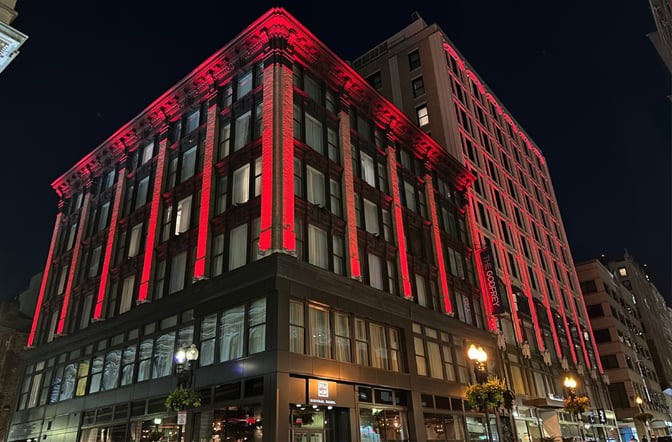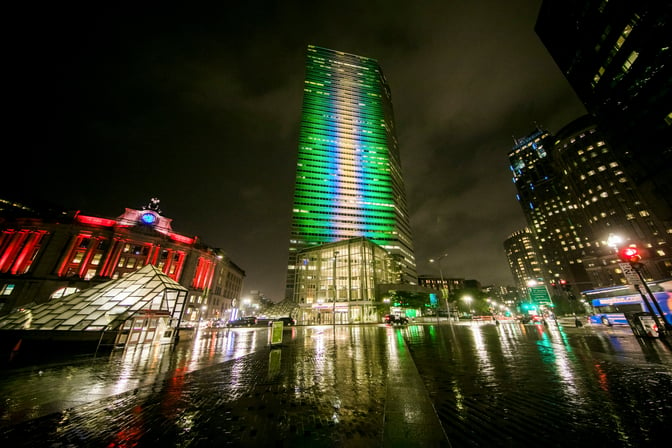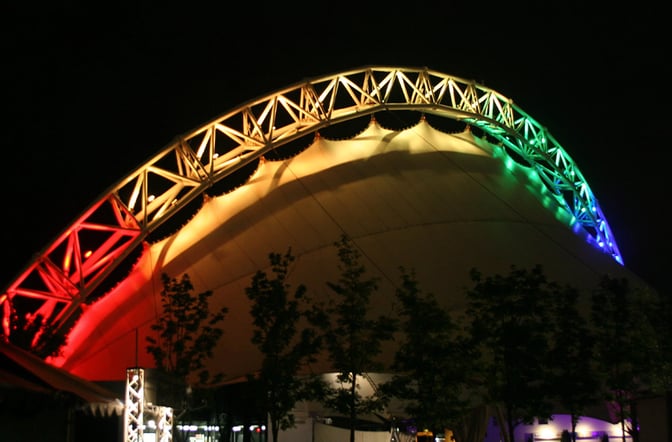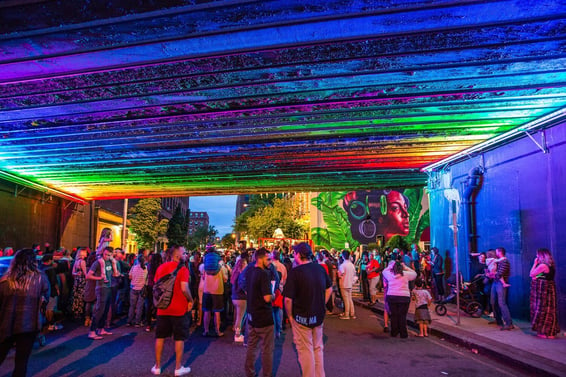Share this
PORT: A Guide to US Architectural Lighting Design
by PORT on Dec 22, 2023 11:59:51 AM
Uncover the secrets behind lighting architecture, creating immersive environments, enhancing aesthetics, and fostering a harmonious balance between light and architecture in architectural lighting design.
December 2023 -
What Is Architectural Lighting Design?
Architectural lighting design encompasses the process of deliberate and strategic planning of fixtures and systems within architectural spaces to achieve specific aesthetic, functional, and
atmospheric objectives.
An architectural lighting designer's role is to enhance the visual and functional aspects of architectural spaces through thoughtful and creative lighting solutions while considering
technical, aesthetic, and practical considerations.
Elements included in the design process are:
• Concept Development
• Mockups/Lighting Design Plan
• Fixture Selection
• Lighting Controls
The architectural designer must know all elements and account for all of them in the design process.
The Process of Architectural Lighting Installation
The design process begins with the need to define and understand the goals and objectives for the lighting design. It is important to understand the function of the space, the look that's wanted, as well as energy efficiency and any budget constraints.
Once this project goal is defined, a site analysis for existing construction is conducted. This site analysis considers factors including but not limited to daylight, natural surroundings, and
architectural features.

Determining these features ahead of time allows consideration of how the artificial lighting will complement and interact with the architecture.
After a site analysis comes a need to understand the architecture. It is key that a designer identifies key design elements, materials, as well as any unique features that should be highlighted or concealed.
Once the architecture is understood, the designer will identify the functional lighting requirements for each area within the space. This can include task lighting for specific activities, general illumination, or accent lighting to highlight specific features.
After a functional analysis, the designer will typically create a lighting plan. This plan will outline the type, quantity, and location of fixtures as well as specify desired light levels, color temperature, and angles for each fixture. Lighting fixtures are chosen to ensure that they meet the design and performance criteria of the design. Color rendering and temperature also go into the fixture selection.
A lighting control system will need to be designed as well to allow for flexibility and adaptability. This control can include dimming, zoning, and scene setting to create different lighting looks.
Why PORT?
When using PORT for your architectural design needs, you can expect support and expertise through every step of the process. Our team has the unique capabilities to design and build your architectural lighting from the ground up using their extensive knowledge of architectural design/installation.
We are happy to provide full turn-key service throughout your project, or we are happy to work with your electrician to ensure your system is installed and programmed efficiently.
What To Expect When Using PORT For Your Architectural Lighting Design
Step 1: Establishing Your Architectural Lighting Needs
The PORT design process starts with an initial call where we will discuss your needs and wants for the desired lighting and aesthetics of your building.
Some questions we may ask can include but are not limited to whether or not your building is an existing structure, whether your building is residential or commercial, as well as what your goals and requirements are to deem this project a success. Establishing these criteria ahead of time is important as it determines how our team will proceed with the next steps.
Step 2: Site Visit From PORT
If your building is new construction and not yet complete, our site visit typically will be conducted over the phone. If your building is existing construction, our team will schedule a time with you to meet on-site. This site visit is important because it allows our team to meet you, review all important design requirements, discuss options, as well as set a time to run a
physical mockup.
During this site visit, our team will walk through and around your site to gather an understanding of how the building is laid out, where power comes from, as well as details that can affect the design and need to be addressed before any installation. All of these steps allow the conception of the requested design to be created, laid out, and achieved.

Step 3: Develop a Rendering & Mockup
Once the site visit has been conducted, our team will create a rendering or use a photo taken during the site visit and create an overlay with lighting. This process allows us to see what the outcome of the project will look like before confirming the design, as well as confirm customer approval.
Following a rendering or photo overlay, our team will arrive on-site again to create a mockup. A mockup with PORT consists of our team bringing in a few different types of fixtures that we feel could work well to achieve the desired effects and test them on a small section of the structure to see which fixtures produce the best results.
This allows us to make adjustments to the fixture selection, and note anything that can affect the lighting such as competing ambient light, physical obstructions, and how the actual building surface reflects/responds to the light.
Mockups and renderings allow us to see potential problems before a confirmed design. Sometimes the way a lighting concept is designed on paper can be different from how it is visually perceived.
Step 4: Creating a Quote
Once we have a PORT and customer-approved mockup or rendering, our team will move into the quoting process. During this process, we will work on creating a bill of materials to help us gather a list of all fixtures and items that are needed to complete the required design.
At PORT we can continue with this design and make it a turn-key project where we cover the job from start to finish. Our team can provide the design, bring in an electrician, and take care of physical installation, commissioning, and programming. We also will provide service and support for as long as we are needed.
If you have an electrician you’d prefer to work with, we are happy to work with your chosen team to ensure the system is installed and programmed the way it needs to be.
LIVE
- Theatrical Lighting Design/Specification
- Theatrical Lighting Installation
- Stage Curtain & Rigging Installation

Want to take this article with you?
Share this
- Event Production (25)
- Event Lighting (20)
- Event Planning (19)
- Lighting Control Systems (15)
- Theatrical Lighting (15)
- event lighting services (15)
- Architectural Lighting (13)
- Lighting Effects (11)
- Architectural Lighting Design (10)
- Theatrical rigging (10)
- Architectural Lighting Installation (7)
- LED Light (7)
- Wedding Lighting (7)
- Theatrical Installations (6)
- Theatrical Lighting Installation (6)
- Installation (5)
- Rigging (5)
- Stage Lighting (5)
- Event Drape (4)
- Lighting Integration Services (4)
- Rigging Inspection (4)
- Design (3)
- Production Design (3)
- Technical Production Management (3)
- Theatrical Lighting Design (3)
- Virtual Content (3)
- Audio-Visual (2)
- Concert Lighting (2)
- Corporate Production Services (2)
- Lighting History (2)
- Sports Lighting (2)
- 3D Rendering (1)
- Bridge Lighting (1)
- Commercial Lighting (1)
- Logistics (1)
- Operations (1)
- Pre-Visualization (1)
- Virtual Event (1)
- April 2025 (1)
- March 2025 (2)
- January 2025 (1)
- December 2024 (1)
- November 2024 (1)
- October 2024 (1)
- September 2024 (1)
- August 2024 (1)
- May 2024 (1)
- April 2024 (1)
- March 2024 (2)
- February 2024 (2)
- January 2024 (3)
- December 2023 (3)
- November 2023 (6)
- October 2023 (1)
- September 2023 (1)
- July 2023 (1)
- March 2023 (1)
- January 2023 (4)
- December 2022 (3)
- November 2022 (4)
- October 2022 (4)
- September 2022 (4)
- August 2022 (2)
- July 2022 (3)
- June 2022 (13)



No Comments Yet
Let us know what you think